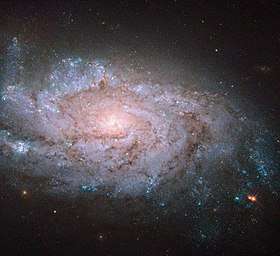NGC 1084
NGC 1084 is an unbarred spiral galaxy in constellation Eridanus. It is located at a distance of about 63 million light-years away from the Milky Way. The galaxy was discovered by William Herschel on 10 January 1785. It has multiple spiral arms, which are not well defined.[6] It belongs in the same galaxy group with NGC 988, NGC 991, NGC 1022, NGC 1035, NGC 1042, NGC 1047, NGC 1052 and NGC 1110. This group is in turn associated with the Messier 77 group.[7]
| NGC 1084 | |
|---|---|
 NGC 1084 by the Hubble Space Telescope | |
| Observation data (J2000 epoch) | |
| Constellation | Eridanus |
| Right ascension | 02h 45m 59.926s[1] |
| Declination | −07° 34′ 43.10″[1] |
| Redshift | 1,406 km/s[2] |
| Distance | 62.7 Mly (19.23 Mpc)[2] |
| Apparent magnitude (V) | 10.7 |
| Characteristics | |
| Type | SAc[3][4] |
| Apparent size (V) | 3′.2 × 1′.8[3] |
| Other designations | |
| LEDA 10464, MCG-01-08-007[5] PGC 10464[3] | |
Star formation in the galaxy is chaotic and not confined to the spiral arms, but the rate is not high enough to classify it as a starburst galaxy. Star formation has taken place in small bursts in the last 40 million years. The cause of this activity has been proposed as a merger with a gas-rich dwarf galaxy. A radio source has been detected 3.5' south-west of the galaxy, connected to it by a bridge.[8] NGC 1084 has been the site of 5 supernovae explosions over a period of 49 years: 1963P (mag. 14), 1996an (Type II, mag. 14), 1998dl (Type II, mag. 16), 2009H (Type II, mag. 17), and 2012ec (Type IIP, mag. 14,5).[9][10]
References
- Skrutskie, M. F.; et al. (2006). "The Two Micron All Sky Survey (2MASS)". The Astronomical Journal. 131 (2): 1163–1183. Bibcode:2006AJ....131.1163S. doi:10.1086/498708.
- Tully, R. Brent; et al. (2016). "Cosmicflows-3". The Astronomical Journal. 152 (2): 21. arXiv:1605.01765. Bibcode:2016AJ....152...50T. doi:10.3847/0004-6256/152/2/50. 50.
- "NASA/IPAC Extragalactic Database". Results for NGC 1084. Retrieved 2016-01-02.
- Ann, H. B.; et al. (2015). "A Catalog of Visually Classified Galaxies in the Local (z ∼ 0.01) Universe". The Astrophysical Journal Supplement Series. 217 (2): 27–49. arXiv:1502.03545. Bibcode:2015ApJS..217...27A. doi:10.1088/0067-0049/217/2/27.
- "NGC 1084". SIMBAD. Centre de données astronomiques de Strasbourg. Retrieved 2020-04-07.
- Eskridge, Paul B.; et al. (November 2002). "Near-Infrared and Optical Morphology of Spiral Galaxies". The Astrophysical Journal Supplement Series. 143 (1): 73–111. arXiv:astro-ph/0206320. Bibcode:2002ApJS..143...73E. doi:10.1086/342340.
- Makarov, Dmitry; Karachentsev, Igor (2011). "Galaxy groups and clouds in the local (z∼ 0.01) Universe". Monthly Notices of the Royal Astronomical Society. 412 (4): 2498–2520. arXiv:1011.6277. Bibcode:2011MNRAS.412.2498M. doi:10.1111/j.1365-2966.2010.18071.x.
- Ramya, S.; et al. (October 2007). "Study of star formation in NGC 1084". Monthly Notices of the Royal Astronomical Society. 381 (2): 511–524. arXiv:0707.2366. Bibcode:2007MNRAS.381..511R. doi:10.1111/j.1365-2966.2007.12232.x.
- "List of Supernovae". IAU Central Bureau for Astronomical Telegrams. Retrieved 29 December 2015.
- "A spiral home to exploding stars". Hubble Space Telescope. 31 March 2014.
External links

- NGC 1084 on WikiSky: DSS2, SDSS, GALEX, IRAS, Hydrogen α, X-Ray, Astrophoto, Sky Map, Articles and images